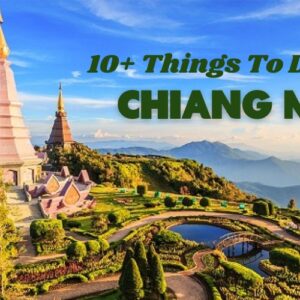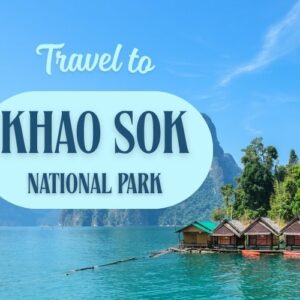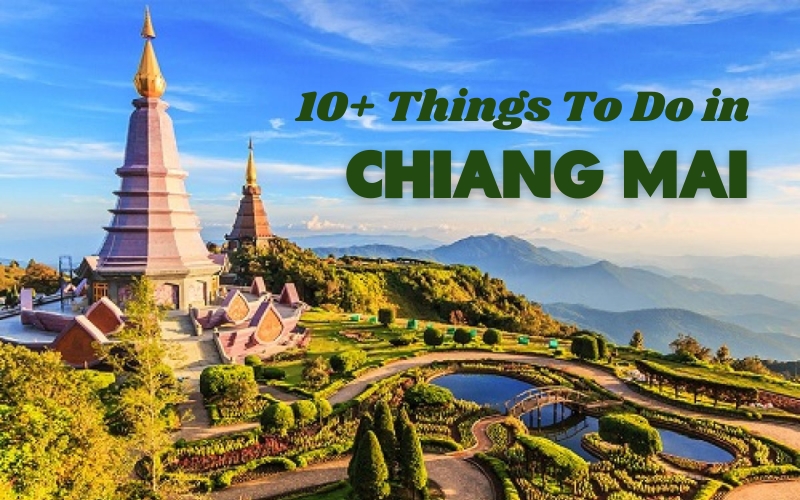
Wondering what to do in Chiang Mai besides visiting temples? You’re not alone – that was exactly what I thought when I first set foot in this peaceful northern city. And I have to say, Chiang Mai surprised me in the best ways. In this guide, I’ve compiled the best things to do in Chiang Mai, based on real-life experiences, a few adventures, and a whole lot of memorable experiences. If this is your first time here, this list will help you discover the magic of Chiang Mai.
Top things to do in Chiang Mai
Discover Chiang Mai’s spiritual side on a temple-hopping tour
One of the first things you’ll notice about Chiang Mai is the deep spirituality of the city. With over 300 temples scattered throughout the city and surrounding hills, visiting temples is sure to be a highlight of your trip, allowing you to experience the local culture on a more peaceful and spiritual level. You’ll find plenty of Buddhist temples in Chiang Mai, some less impressive, some more famous, and some that just pop up as you walk by.
The most iconic temples in Chiang Mai
On my first morning in Chiang Mai, I started at Wat Phra Singh, located right in the heart of the Old City. The golden roofs, intricate wood carvings, and tranquil courtyards immediately drew me in. Locals came to offer incense and lotus flowers, and the atmosphere was incredibly peaceful. Just a few streets away, I walked into Wat Chedi Luang, which has a crumbling Mayan-style stupa dating back to the 14th century.
If you’re feeling a little adventurous, you can get to Doi Suthep by songthaew from the city center – they’re easy to find, or you can ask your hotel reception for the nearest place to catch one. Wat Phra That Doi Suthep is one of the most famous and impressive temples in Chiang Mai. It’s a sacred site for Buddhists, who come here to pray, despite the crowds of tourists. You’ll need to climb over 300 steps to get to the top but the view from the top is worth it. I remember arriving early in the morning, just as the monks were chanting – the sound echoing through the temple is something I’ll never forget.
To finish your temple tour, head to Wat Phra That Doi Kham and watch the sunset from the top of the hill. For me, the best part of this temple is the long staircase flanked by the legendary Naga snakes. And the panoramic view of Chiang Mai and the surrounding valleys. It’s especially beautiful at sunset. That’s why I recommend visiting at this time of day.
Pro tips:
- Dress modestly (shoulders and knees covered) and always take off your shoes before entering a temple.
- I recommend mixing up the famous temples with the smaller, less crowded ones, as sometimes it’s those quiet corners where you can really feel the spirit of Chiang Mai.
- Many temples accept small offerings at the entrance. This is optional, but a donation of a few baht goes towards the upkeep of the temple and is considered a good merit.
> > > Curious about which temples are truly worth your time? Don’t miss our full guide to the best temples to visit in Chiang Mai, from the iconic Wat Phra That Doi Suthep to hidden gems tucked away in the Old Town.
Take a guided food tour in Chiang Mai
One of the best ways to learn about the culture and enjoy the local cuisine is to take a food tour. Thai cuisine is world-famous, but those familiar with it may be surprised by the stark differences between authentic northern cuisine and southern Thai cuisine, such as Bangkok and Phuket. I booked a small-group evening tour with a local guide, and honestly it was one of the highlights of my trip.
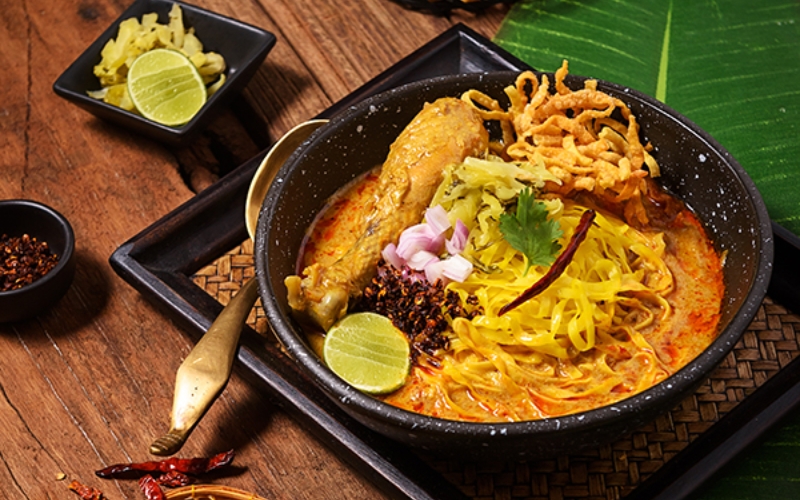
A bowl of authentic khao soi, the signature dish of Chiang Mai
If Chiang Mai has a signature dish, it’s Khao Soi: a coconut curry soup topped with crispy noodles. It’s a bit spicy and often served with chicken, beef, shrimp, or braised tofu. You’ll find it everywhere, from street stalls to fine dining restaurants. I’ve tried khao soi before, but this version from a quiet family restaurant near the old town really blew me away. I had it for breakfast several times during my trip – it was that good!
Other dishes include fried laab, minced meat marinated in a variety of local spices before being grilled on a grill, or nam ngiao, a spicy tomato soup with diced pork. Along the way, you’ll encounter a variety of Thai specialties, including Pad Thai and other vegetarian dishes.
Pro Tips:
- Look for local tour guides as they will show you hidden eateries that are popular with locals, providing insight and possibly ingredients about the dishes. But be sure to choose a tour with fewer people for the best experience.
- Thai food is known to be quite spicy, so if you don’t eat it, ask for less spicy or no spicy. Don’t hesitate to try dishes you may have heard of for the first time, such as fermented pork sausages, fried silkworms, or sweet banana roti sold on street carts.
Walk through the charming Old Town
After all that delicious food, you might want to walk to burn it off. Just a few minutes away, you can find another great spot in Chiang Mai – the Walking Street. This square area, surrounded by a moat and the ruins of ancient walls, is the historical and cultural heart of the city. It is in this space that you can find some of the original temples, along with some of Chiang Mai’s best museums and art galleries. And honestly, it’s one of the best places to explore slowly, on foot, without too much planning.
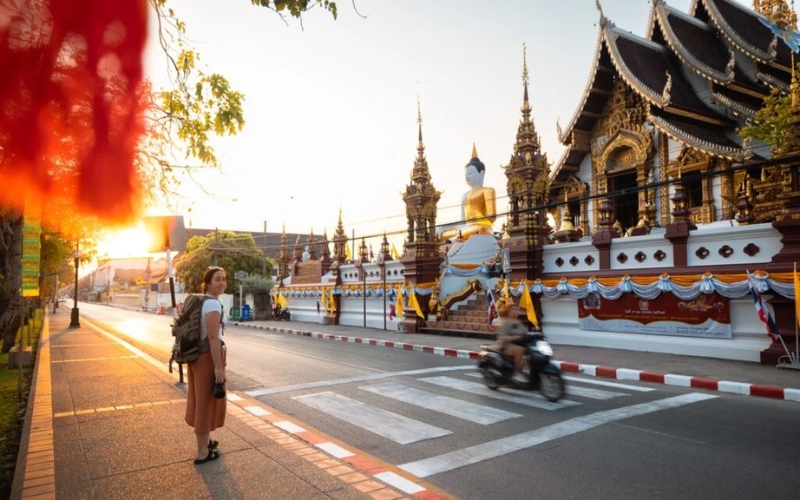
A quiet morning in the heart of the Old Town
Wander the small alleys, take a look at the small temple courtyards, where orange-robed monks chat quietly under the trees. Nearby, you can find a quiet cafe with old wooden doors, the smell of fresh coffee wafting down the street. That’s what makes the Old Town special, full of peaceful surprises. If you go there on a Sunday, the whole area transforms into the Sunday Walking Street Market, with colorful stalls, live music and street food all over the main road. The market is crowded but the atmosphere is great.
Pro Tips:
- Stay downtown if possible as you can easily reach all the destinations
- Wear slippers or comfortable walking shoes as you will be doing a lot of walking on uneven pavements and you can easily get 10,000 steps without trying.
- In my opinion, the best time is in the morning when the air is calm and cool or in the afternoon when it is lighter and the atmosphere becomes more lively.
Experience the nightlife
Personally, I didn’t expect much from the nightlife at first – I thought Chiang Mai was all about temples and mountains. But after just one evening out, you’ll be hooked. One of my favourite spots is the Night Bazaar near Tha Phae Gate. Stalls are set up on the walkways and in the middle of the road, selling everything from clothes to jewellery. Once you’ve seen it all, head to the local boxing stadium for a Muay Thai session.
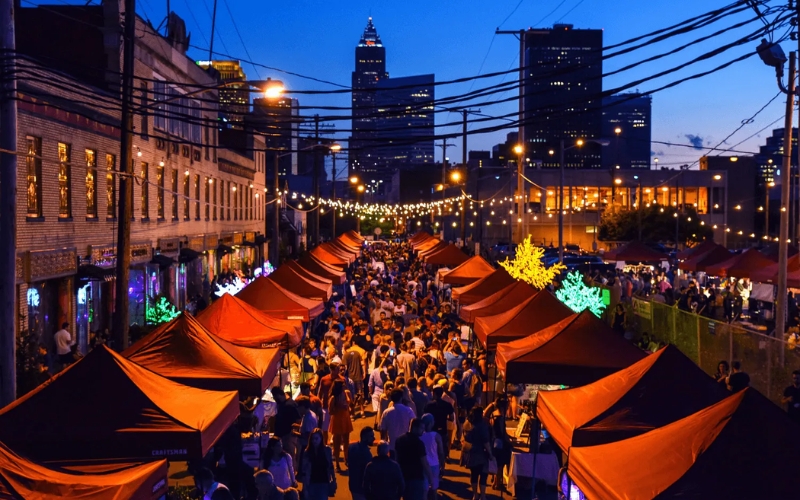
Colorful night market under the lights
If you’re in the mood for something a little more hip, head to Nimmanhaemin Road (known locally as “Nimman”). This is Chiang Mai’s hipster district, with stylish rooftop bars, jazz lounges and cafes that turn into pubs after dark. I really like Rise Rooftop Bar – it has great views of the city, chilled out music and isn’t too crowded.
Pro Tips:
- You can dress comfortably when walking around, but avoid anything too revealing or too short.
- Pay attention to local laws, bars and pubs usually close before midnight, and loud parties are not allowed in residential areas.
Take part in some iconic festivals
Chiang Mai has a packed calendar of festivals and events. In November, two lantern festivals take place, creating a sparkling skyline, punctuated by joyous spectacles on the ground. The two festivals are Loy Krathong and Yi Peng. Loy Krathong is a magical event that celebrates the Goddess of Water and the end of the rainy season. Locals gather along any body of water, from lakes to canals, and release candle-filled rafts and krathongs (lanterns) into the sky.
I was lucky enough to visit during the festival and the experience was magical. Thousands of lanterns gently float into the sky, casting a warm glow across the city, it was romantic and peaceful. I released one too, silently making a wish as it rose. The locals told me it was a symbolic way to ward off bad luck and honestly, it felt so peaceful.
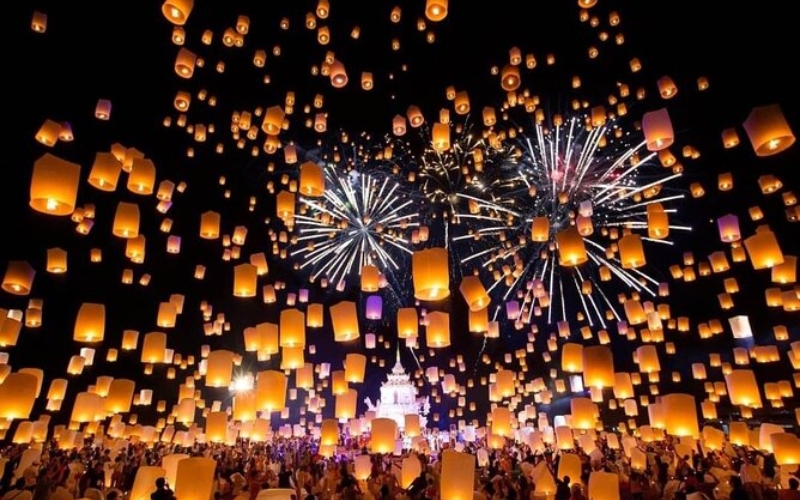
Floating lanterns lighting up the night at Loy Krathong festival
Songkran, however, is still the most vibrant of all festivals in Chiang Mai. While you can enjoy this unique yet exciting festival all over Thailand, Chiang Mai has its own unique twist. This New Year’s celebration is held every April and lasts for several days, both exciting and tiring. The moat surrounding the Old City becomes a popular gathering point to fill buckets with water before wetting anyone who passes by. Each splash of water symbolizes a blessing.
Pro Tips:
- If you plan to visit during these festivals, book your accommodation and flights at least 2-3 months in advance.
- Arrive 1-2 days before the festival so you can explore Chiang Mai before the crowds start to build up and you can feel the festival atmosphere more clearly.
- While the festivals are lively and fun, don’t forget that they still have a deep spiritual meaning for the locals. So learn the dos and don’ts before joining to avoid misunderstandings.
Hike to the roof of Thailand at Doi Inthanon National Park
Dubbed the “Roof of Thailand,” Doi Inthanon is the highest mountain in Thailand, rising 8,415 feet (2,564m) above sea level. Less than a two-hour drive from the city, Doi Inthanon National Park is a great place to breathe in the fresh mountain air, hike, and see some of the most beautiful temples in northern Thailand.
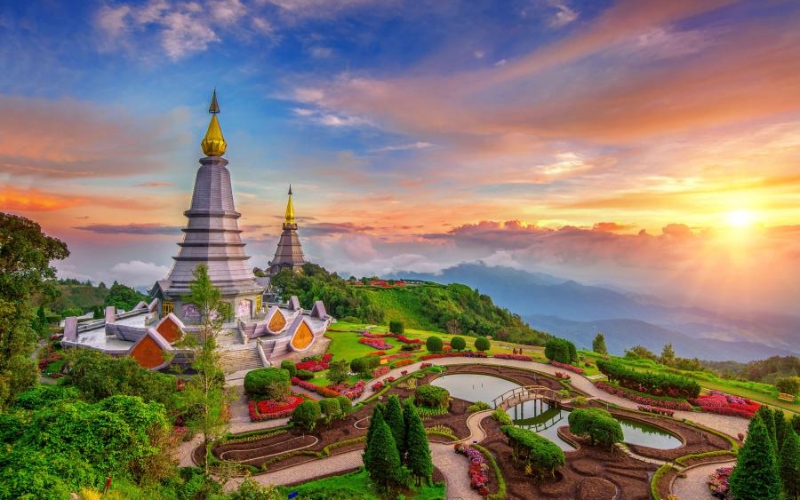
Breathtaking views from the summit of Doi Inthanon
For those willing to brave the sunny skies, you have two options for hiking to the top of Thailand’s mountain. The first is the short and pleasant Ang Ka Luang Trail, which starts very close to the summit. Or the longer 2.1-mile Kew Mae Pan Trail, which leads through wildflower forests on the way to the summit. The trails themselves aren’t particularly difficult or steep, but hiring a local guide is still recommended to make the trek more enjoyable. And don’t miss the most iconic sights in the national park, the Queen’s Pagoda and the King’s Pagoda, housing some historical relics and are great places for photos.
Pro tips:
- The timings at Doi Inthanon can vary quite dramatically. According to locals, the mornings are usually the best and clearest. If you go a little early, you’ll get a discount on the commentary warnings from the top.
- There are a variety of trails to choose from, depending on your fitness level. Some are short and easy, while others are longer and deeper into the jungle.
- If you’re not on a tour, hire a motorbike or private driver for the day as it can be difficult to catch a ride from here, and public transport is not available.
Ride the scenic Mae Hong Son Loop
When you arrive in Chiang Mai, you should spend some time exploring the lush, majestic mountains, where you will find alpine villages, tribal communities and the beautiful city of Pai. I did this loop in 4 days on a rented 150cc motorbike, and honestly, it was one of the highlights of my trip to Thailand. You can refer to my route: Chiang Mai – Mae Sariang – Mae Hong Son – Pai – back to Chiang Mai, and each stop has its own charm.

The scenic drive through the mountains of Mae Hong Son
As you leave the city, with the cool breeze on your shoulders, you will feel a sense of freedom and refreshment. The roads lead up to majestic mountain peaks, taking you through the morning mist to admire the majestic scenery. Lunch is served at small markets, giving you the most authentic feeling of life in the Thai countryside.
Pro Tips:
- Check your car skills before starting the process such as wheels, brakes, racing, etc. Try a short distance first to get used to the car.
- Dressage roads can be foggy or slippery at night, many sections are also lightly lit so arrive at the stop or finish it before 6pm to ensure safety.
> > > Want to explore even more beyond Chiang Mai? The 7 Days Northern Thailand Discovery tour is the perfect way to dive deeper, taking you from Chiang Mai’s charm to hidden gems like Pai, Chiang Rai, and Mae Hong Son. It’s the ideal journey for travelers craving both cultural depth and scenic adventure.
Climb up Bua Thong Waterfall, “Sticky Waterfall”
Unfortunately, I didn’t have enough time to visit Bua Thong Waterfall – but I couldn’t leave it off this list because it sounds amazing! Located about an hour and a half north of the Old City, this is no ordinary waterfall. What makes it special is that you can actually walk up to it barefoot, without slipping. The rock surface has a natural grip, almost like a natural sponge. That’s why it’s called Sticky Waterfall near Chiang Mai.
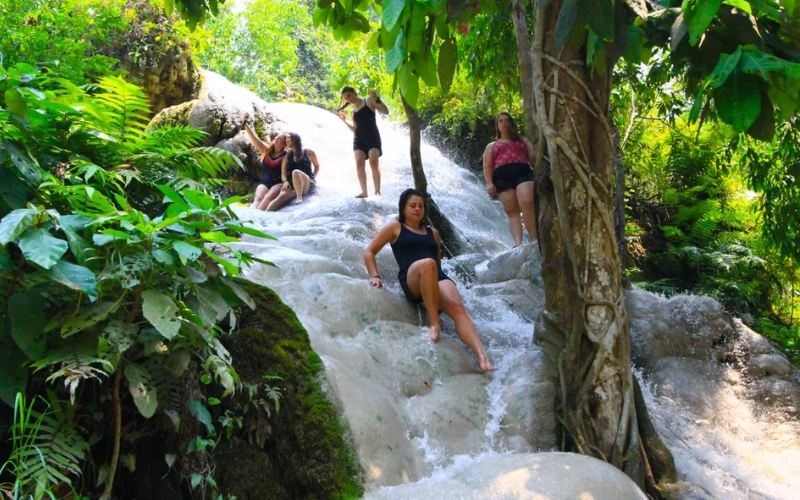
Climbing up the Sticky Waterfall in Chiang Mai
It feels a little strange at first, but it’s surprisingly safe. There are ropes to help, but much of the climb is so easy that you hardly need them. There are several tiers of this waterfall, but the most exciting is at the bottom, where the falls drop about 9 meters and you can climb around them. Once you’re done, head up the small steps opposite the falls to a clear stream. It’s a great way to cool off on a hot day!
Pro Tips:
- Take extra clothes and a waterproof bag just in case you get wet.
- If you’re afraid of going barefoot, you can wear waterproof shoes or sandals, but honestly, barefoot gives you the best grip.
See elephants in Chiang Mai the responsible way
Chiang Mai is famous for its elephants, however, sadly there are only a few ethical sanctuaries that allow elephants to roam free and not interact with tourists. The best ethical elephant sanctuary in Chiang Mai is Chang Chill – you can book a full day tour here, where you can watch the elephants roam freely and help prepare their food. I spent the whole day in the sanctuary, starting the morning with a short orientation on elephant behavior, their past in Thailand’s tourism and logging industries, and how sanctuaries like this are working to rehabilitate them.
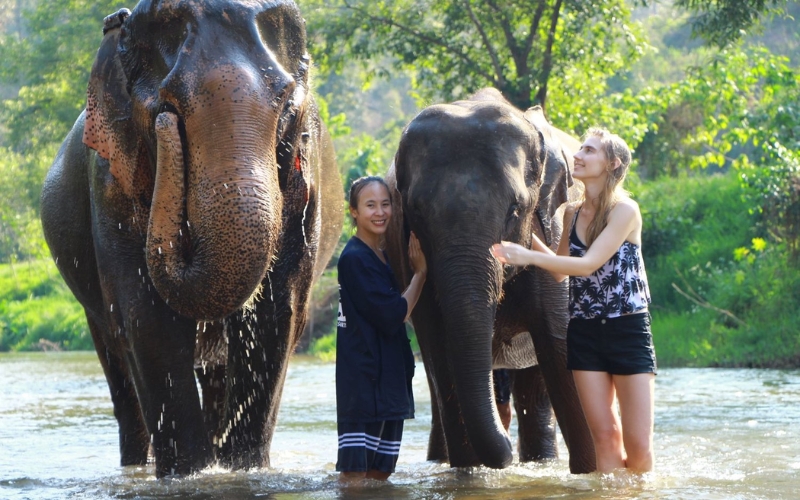
You can interact with elephants the responsible way
Then came the magic: feeding time. I got to hand feed bananas and sugar cane to a group of rescued elephants – each with their own quirks and personalities. One kept stealing from another, another was extremely shy, and a baby elephant kept wagging its ears whenever anyone walked by. It was amazing to see an elephant up close. Seeing them up close, you realize how intelligent and emotional they are.
Pro tips:
- Wear clothes that you don’t mind getting muddy or wet, especially if you’re joining elephants in rivers or mud pits. Quick-drying clothes are best.
- Book in advance during peak season (November to February) as ethical sanctuaries tend to fill up quickly due to limited visitor numbers.
- Book directly with the sanctuary rather than through a third party whenever possible as this will directly support the organization and ensure you get to the right place.
Paddle down river with a bamboo raft

Floating gently downriver on a traditional bamboo raft
Floating down the river on a bamboo raft is one of the most relaxing (and scenic) ways to experience rural Chiang Mai. The raft itself is incredibly simple: long bamboo poles tied together, floating low on the water. At first, I was worried about getting wet, but to my surprise, it held its balance.
Imagine floating on a rustic bamboo raft along a river that cuts through tranquil jungles. The raft takes you through the windings of the river, where you can observe the lives of the people on both sides of the river or, if you’re lucky, spot elephants wandering along the banks. Even though it’s less than an hour from Chiang Mai, you’ll feel like you’re a world away from the city.
Pro tips:
- Ask if you can try steering! Some guides will happily let you hold the pole for a bit (but don’t expect to go in a straight line).
- Check the water levels if you visit during the dry season (February–April) as some sections of the river may be too shallow to fully enjoy.
- Bring a waterproof bag for your phone, camera or valuables. Although this is a gentle ride, there may be sudden splashes or shaking.
Take a Thai Cooking Class
One way to bring home a taste of Chiang Mai is to take a local cooking class. Here, you’ll learn how to master the delicate balance of salty, spicy, and sweet that characterizes Thai cuisine. And trust me, it’s one of the most fun (and delicious) ways to get a deeper understanding of Northern Thailand. The hardest part is choosing a cooking school, as there are so many to choose from. Most cooking classes in Chiang Mai start with a tour of the local market. Choose the dish you want to cook, and your guide will take you through rows of fresh herbs, spices, and vegetables to shop for the ingredients.
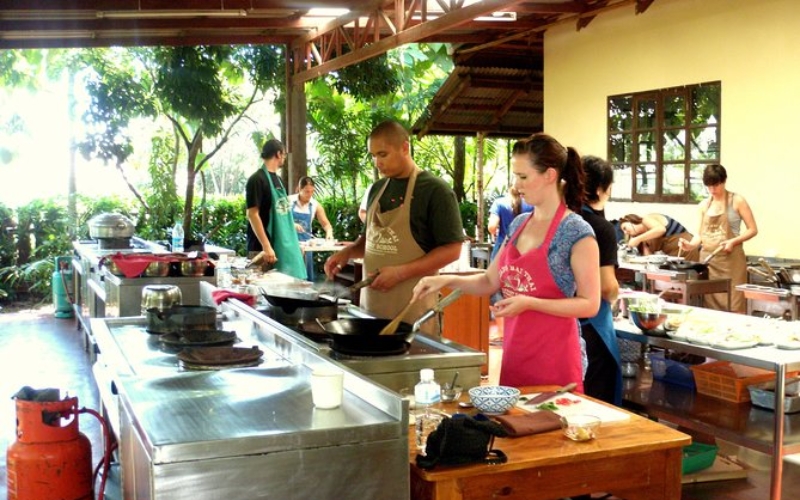
Tourists enjoy a Thai cooking class in the countryside
The best part? The class is held in a family-style outdoor kitchen, surrounded by a small herb garden, which makes for an intimate and authentic feel. Everyone has their own cooking station, and the instructors are funny, patient, and incredibly knowledgeable. You will cook, laugh and enjoy the food together.
Pro Tips:
- Find a class that suits you. Vegetarian, vegan, gluten-free, low-spicy? Most schools are very accommodating if you let them know in advance. You will still get the full experience.
- It can get hot in the cooking area, so wear light, comfortable clothing and don’t wear white unless you want a souvenir curry stain.
Itinerary ideas for your Chiang Mai trip
Wondering how to make the most of your time in Chiang Mai? Here are a few itinerary ideas based on how long you’re staying, whether it’s a quick visit or a week-long adventure, these plans will help you hit the highlights without feeling rushed.
Itinerary 1: 5 Days Chiang Mai & Northern Thailand Discovery
Day 1: Arrival in Chiang Mai
Day 2: Explore Chiang Mai City and Temples
Day 3: Explore Wat Prathat Doi Suthep
Day 4: Explore Baan Hui Parai Hill Tribe Village & Orchid Farm
Day 5: Depart Chiang Mai
For a more detailed itinerary, please check this link here.
Itinerary 2: Ultimate Northern Thailand 12 Days Discovery
Day 1: Arrive in Chiang Rai, Evening City Tour
Day 2: Nature Walk & Waterfall Picnic
Day 3: Highlights of Chiang Rai
Day 4: Lisu Lodge & Eco-Tourism
Day 5: Biking, Exploring Tea Garden, River Rafting & Thai Cooking Class
Day 6: Thai Sticky Rice Cooking Class, Transfer to Pai
Day 7: Yuan Lai Sunrise, Explore Tham Lod Caves, Visit Ja Bo & Kiew Lom
Day 8: Transfer to Chiang Mai, Explore Huay Nam Dang National Park
Day 9: Half-Day Kanta Elephant Sanctuary Experience
Day 10: Nature Excursion at Doi Inthanon National Park
Day 11: Half-Day at Baan Kang Wat & Wat Umong
Day 12: Depart Chiang Mai
For a more detailed itinerary, please check this link here.
Some useful tips for your Chiang Mai trip
Before you pack your bags for Chiang Mai, here are some practical tips to help you make the most of your visit.
- Travel at the right time: the best time to travel to Chiang Mai is from November to February. The weather is dry and cool, the temperature is comfortable and the sky is always clear, suitable for any activity. You should avoid March and April because this is the harvest season in Chiang Mai. Farmers burn the stubble in the fields after harvesting, which can create a lot of smoke that affects your health and experience.
- Get around Chiang Mai: Chiang Mai is quite small and if you stay in the old town, walking is the most convenient and easiest way to get around, you can explore every corner just a few steps away. For further destinations, there are also many options for you. You can rent an electric bike (with a rental price of about $5 – $8 a day) or travel by ride-hailing apps. You’ll also see lots of red trucks (called songthaews) driving around; they work like shared taxis. Just flag one down, say where you’re going, and agree on a price (around $0.80–$1.60) per person.
- Choose the right place to stay: If it’s your first time in Chiang Mai, I recommend staying in or near the old town as most of the attractions like temples and night markets are just a short walk away. For a more upscale, peaceful experience, book a riverside hotel or mountain resort outside the city. Many will offer free bikes or shuttle services, so ask before booking.
- Plan to go during festivals: Festivals are always a highlight of any trip. Chiang Mai’s most famous festival is Loy Krathong (in November), when thousands of lanterns are released into the night sky, creating a magical and romantic scene, especially suitable for a honeymoon. Chiang Mai is also one of the biggest Songkran (in April) celebrations in Thailand. Just be sure to book your services 1-2 months in advance.
- Always carry cash: unlike big cities like Bangkok or Phuket, cash is the main form of payment in Chiang Mai, although a few upscale restaurants and hotels may accept cards. Exchange cash at banks or ATMs, but be aware that there may be a fee.
- Be wary of elephant sanctuaries: Chiang Mai is famous for elephant tourism, but not all sanctuaries are ethical. If you see a place that allows you to ride an elephant or watch an elephant show, don’t hesitate to report it to the local authorities to help preserve the species.
With this list, I hope you feel inspired and excited to explore Chiang Mai. Whether you love culture, food, nature or simply enjoy the slow pace of Northern Thailand, there is something for everyone. If you need help planning your trip or want to know more about where to stay, eat or visit an elephant sanctuary, don’t hesitate to contact us now. I would love to share more about my trip to Chiang Mai and help you make the most of it.
Read more:
